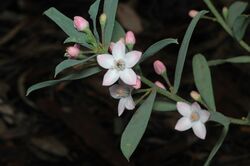Biology:Philotheca myoporoides subsp. brevipedunculata
| Philotheca myoporoides subsp. brevipedunculata | |
|---|---|

| |
| In the Australian National Botanic Gardens | |
| Scientific classification | |
| Kingdom: | Plantae |
| Clade: | Tracheophytes |
| Clade: | Angiosperms |
| Clade: | Eudicots |
| Clade: | Rosids |
| Order: | Sapindales |
| Family: | Rutaceae |
| Genus: | Philotheca |
| Species: | |
| Subspecies: | P. m. subsp. brevipedunculata
|
| Trinomial name | |
| Philotheca myoporoides subsp. brevipedunculata Bayly[1]
| |
Philotheca myoporoides subsp. brevipedunculata is a subspecies of flowering plant in the family Rutaceae and is endemic to New South Wales. It is a shrub with oblong or egg-shaped leaves and white or pink flowers arranged singly or in groups of up to three in leaf axils.
Description
Philotheca myoporoides subsp. brevipedunculata is a shrub that typically grows to a height of 1.8–2 m (5 ft 11 in–6 ft 7 in) with glabrous, densely glandular-warty stems. The leaves are leathery, oblong-elliptic to egg-shaped with the narrower end towards the base, 10–30 mm (0.39–1.18 in) long and 5–10 mm (0.20–0.39 in) wide and there is a small point on the tip. The flowers are usually arranged singly, sometimes in twos or threes, rarely four, in leaf axils on a peduncle up to 2 mm (0.079 in) long, each flower on a thin pedicel 4–8 mm (0.16–0.31 in) long. The petals are broadly elliptic, about 8 mm (0.31 in) long with a prominent keel. The stamens are free from each other and hairy near the base. Flowering mainly occurs in spring and autumn.[2][3][4][5]
Taxonomy and naming
This subspecies was first formally described in 1998 by Michael Bayly in the journal Muelleria.[4][6]
Distribution and habitat
This subspecies grows from coastal to escarpment ranges from Sassafras to the Moruya district in south-eastern New South Wales.[3][2]
References
- ↑ "Philotheca myoporoides subsp. brevipedunculata". Australian Plant Census. https://biodiversity.org.au/nsl/services/apc-format/display/178898. Retrieved 7 August 2020.
- ↑ 2.0 2.1 Herscovitch, Clare. "Philotheca myoporoides subsp. brevipedunculata". Royal Botanic Garden Sydney. http://plantnet.rbgsyd.nsw.gov.au/cgi-bin/NSWfl.pl?page=nswfl&lvl=in&name=Philotheca~myoporoides~subsp.+brevipedunculata. Retrieved 7 August 2020.
- ↑ 3.0 3.1 Wilson, Paul G. (2013). Flora of Australia (Volume 26). Canberra: Australian Biological Resources Study. p. 392. https://profiles.ala.org.au/opus/foa/profile/Philotheca%20myoporoides%20subsp.%20brevipedunculata. Retrieved 7 August 2020.
- ↑ 4.0 4.1 Bayly, Michael J. (1998). "Notes on the Eriostemon myoporoides (Rutaceae) species complex, including new names and a new generic placement in Philotheca". Muelleria 11: 121. https://www.biodiversitylibrary.org/page/51253590#page/125/mode/1up. Retrieved 7 August 2020.
- ↑ Rozefelds, Andrew C.F. (2001). "Notes on the Philotheca myoporoides complex (Rutaceae) in Victoria. Muelleria 15". Muelleria 15: 17–18. https://www.biodiversitylibrary.org/item/207394#page/19/mode/1up. Retrieved 7 August 2020.
- ↑ "Philotheca myoporoides subsp. brevipedunculata". APNI. https://id.biodiversity.org.au/instance/apni/560320. Retrieved 7 August 2020.
Wikidata ☰ Q66104756 entry
 |


